Are Oil Diffusers Or Candles Better?
Introduce the Topic
Oil diffusers and candles are two popular options for scenting and aromatherapy in the home. Both can fill a space with pleasant fragrances, but they work in different ways.
An oil diffuser is an appliance that disperses essential oils into the air. It draws up the oil and breaks it into micro-droplets using ultrasound waves or heat. These droplets are circulated around the room by a quiet fan, infusing the air with aromatic oil molecules.
Candles also release fragrance into the air, but through a flame heating process. As the candle wax melts and the wick burns, fragrance compounds get released into the air through evaporation.
Both oil diffusers and candles can be used to freshen up a home, improve mood, mask odors, and provide aromatherapy benefits. But they have some differences in safety, effectiveness, cost, and convenience.
Aromatherapy Benefits
Both candles and oil diffusers can provide aromatherapy benefits through dispersing pleasant scents and essential oils into the air. However, diffusers are generally more effective for harnessing the positive effects that different essential oil aromas can provide.
Inhaling essential oils from certain plants and flowers has been shown to influence mood, reduce stress and anxiety, promote relaxation, and improve sleep. For example, lavender oil is known for its calming properties, lemon oil can boost energy and mood, and jasmine oil may help reduce anxiety. Diffusing oils makes it easy to experience these benefits.
Oil diffusers allow you to control the type and concentration of essential oils dispersing into the air. They also provide greater fragrance coverage than candles. With a diffuser, you can pick an oil blend suited for your needs at that moment, whether it’s an energizing citrus scent in the morning or a calming lavender at night. This level of customization and versatility isn’t possible with candles.
Health and Safety
When choosing between candles and oil diffusers, it’s important to consider potential health and safety issues. Strong scents from either can worsen allergy or asthma symptoms in sensitive individuals. Test out new fragrances in small amounts first. Keep wicks trimmed on candles, and extinguish them before leaving a room to prevent accidental fires. Oil diffusers pose less of a fire risk, but essential oils can still irritate for some. Place diffusers away from pets and young children to avoid possible toxicity if oils are ingested. Try natural beeswax or soy candles to reduce smoke. Overall, oil diffusers may be the safer choice for home use, but both require some precautions.
Odor Coverage
When it comes to odor coverage, both oil diffusers and candles can effectively scent rooms of various sizes. However, there are some key differences to consider.
Oil diffusers use water and essential oils to disperse fragrance into the air. The fine oil droplets are carried throughout the room via air currents, providing even and consistent diffusion. Most quality diffusers can scent rooms up to 430 square feet. Some high-end models have larger water reservoirs and stronger motors to cover over 750 square feet.
Candles rely on hot wax and natural convection to spread fragrance. The strength and spread will depend on the size of the candle, room airflow, and burn time. A large pillar or container candle can scent up to 300 square feet. Votive candles have a much smaller scenting range of around 70 square feet.
In general, oil diffusers tend to provide a wider and more consistent dispersion of fragrance compared to candles. But both can be effective options for scenting rooms of various sizes and layouts.
Cost Comparison
When considering cost between oil diffusers and candles, there are both upfront and operating costs to examine.
Oil diffusers often have a higher upfront cost, with prices ranging from $10 on the low end to $100 or more for high-end models with features like lights, timers, and remote controls. However, the oils themselves tend to cost between $5-$15 for a small bottle. Operating costs are low since you only need a few drops of oil per use.
Candles can be very inexpensive to purchase, with prices from $1 to $50 depending on size, fragrance, design, etc. However, the operating costs are higher since you need to purchase a new candle once the wax is used up. Consistently buying new candles adds up over time.
When it comes to total cost comparison, oil diffusers often come out ahead in the long run. The higher upfront investment pays off since the operating costs are lower. Candles have lower startup costs but must be repurchased frequently, leading to higher lifetime costs.
Variety of Scents
When it comes to the variety of scents available, essential oils offer far more options compared to candles. With candles, you’re limited to the fragrances that manufacturers produce. Typically, a candle brand may offer anywhere from 5-50 distinct scents. With essential oils, there are hundreds of different single note oils to choose from. Popular oils like lavender, peppermint, lemon, and frankincense are just the tip of the iceberg. You can find unique essential oils like clove, ylang ylang, rosemary, and jasmine that provide exotic and complex aromas not usually found in candles.
The ability to blend oils is another advantage. By combining different essential oils, you can create custom perfume-like aromas. For example, blending citrus oils like grapefruit, lemon, and orange can produce an uplifting medley. Or you can create a relaxing blend by mixing lavender, bergamot, and chamomile. With candles, you’re stuck with the scents as they are manufactured. So essential oils offer far more variety when it comes to choosing and even mixing fragrances.
Convenience Factors
When it comes to ease of use, oil diffusers tend to be more convenient and require less maintenance than candles. Oil diffusers simply need to be plugged in, filled with water and a few drops of essential oil, and turned on. Once the water runs out, they just need to be refilled. There is no flame to attend to and snuff out like with candles. Candles require more care – the wick needs to be kept trimmed to maximize burn time and prevent excess smoke, and the melted wax needs to be cleaned up as the candle burns down. Oil diffusers also last longer than candles before needing a refill. The essential oils in diffusers can scent a room for weeks or months, while a candle will burn out after several hours to a few days max.
In terms of refills, both candles and essential oils need to be replenished, but oils tend to be easier to refill into a diffuser. Most diffusers have a simple reservoir that’s uncovered to add more oil. Candles need to be completely replaced when they’ve burnt out. When it comes to maintenance, oil diffusers require occasional cleaning to prevent mold growth, while candle holders need to be cleaned of wax buildup. Overall, oil diffusers provide more convenience and ease of use compared to candles.
Ambiance Features
Both oil diffusers and candles can enhance the ambiance of a space, but they offer different features for doing so. Oil diffusers often provide customizable colored lights and mist effects that can be turned on and off as desired. For example, many diffusers have LED lights that allow you to select a single color or rotate between multiple colors to set a certain mood. The mist they emit can also create a relaxing atmosphere, and some models have settings to adjust the thickness, height and intervals of the mist. This allows you to control the look and intensity of the mist to your liking.
Candles certainly provide a beautiful ambiance as well, with their flickering flames. However, they offer less customization in terms of lighting features. You’re limited to the single, natural light of the candle flame, without colored lights or adjustable mist. Some candles try to provide visual interest through the color of the wax, container, or embeds, but these elements remain static. Oil diffusers offer more opportunities to create an ambiance that fits your mood or activities through their various light, mist and color settings.
Environmental Impact
When it comes to environmental impact, both candles and oil diffusers have pros and cons. Candles are often made from paraffin wax, which is a petroleum byproduct. Paraffin wax can emit toxins like benzene and toluene when burned, polluting indoor air. However, there are candle options made from natural soy, beeswax, and other eco-friendly waxes. The reusable glass jars can also be recycled. Oil diffusers use electricity, but many models have eco modes and auto shut-off features to conserve energy. The oils themselves are renewable and reusable in most cases. However, some disposable plastic diffuser parts may end up in landfills. Ultimately, consumers should look for renewable, reusable, and recyclable factors when choosing either candles or diffusers.
Summary and Recommendations
Overall, both oil diffusers and candles have benefits depending on your needs and preferences. Here are some key comparisons between the two aromatherapy options:
- Oil diffusers generally provide stronger, more consistent fragrance than candles. The aroma from candles can be light and dissipate faster.
- Diffusers distribute scent more evenly throughout a space. Candle fragrance is often localized around the flame.
- Both can set a desired mood and ambiance. Diffusers offer more flexibility to change scents. Candles create a visual ambiance.
- Safety-wise, diffusers avoid the open flame of candles. However, over-use of oils can cause sensitivities.
- Diffusers tend to cost less per use, though the upfront cost is higher. Candles are very affordable but need frequent replacement.
- There’s wider variety and more natural scents available for diffusers. Candles come in many but more synthetic fragrances.
- Diffusers require filling and cleaning. Candles simply need lighting. But some candles require special care to not burn too quickly.
With these factors in mind, diffusers may work better for aromatherapy benefits, especially in large spaces. Candles can provide visual ambiance and great lighter scents for small spaces. Consider using both in different rooms or situations to take advantage of their unique strengths.


